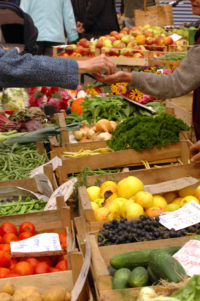From Local to Regional: Defining Vermont’s Foodshed
March 24, 2014

Throughout the planning process developing Vermont’s “Farm to Plate” Strategic Plan, we heard many definitions about what the geographic boundaries of “local food” means to different people. Early localvores often used a 30, 50 or 100 mile radius, while others believe local to be a broader, more regional concept. Labeling food as local is important to consumers as well as producers, processors, distributors, and retailers along the value chain.
The Farm to Plate Strategic Plan aligns with the State of Vermont’s definition of local: food that is produced or processed within a 30 mile radius of any given locale. So when you take the perspective of the state as a whole, this means that “local” is “Vermont+30 miles”; which includes any place in New York, southern Quebec, New Hampshire, and Massachusetts that is within 30 miles of Vermont’s border. Some have agreed with this definition and others have found it to be too broad or too narrow. We define “regional” to include the six New England States, plus New York and southern Quebec.
While we have adopted this geographic definition, the Farm to Plate Network continues to wrestle with the concept of exactly WHAT gets counted. Everyone agrees that if it’s grown here, it’s local. But how about specialty foods: the salsa that uses Vermont grown tomatoes only in summer or the bakery that has only one product which uses local wheat? How about coffee and peanut butter products? When it comes to processed foods, it gets complicated. We want to support processing businesses adding value to Vermont grown foods, but we don’t want to ignore the importance of local food manufacturers that may not be using local ingredients yet do create livable wage jobs here in the state.
Legislatively, Farm to Plate is about creating economic development opportunities and jobs in the farm and food sector, and increasing access of healthy, local food for all Vermonters. The Plan’s 25 goals which we hope to reach by 2020, include: increasing farm viability, improving the environment, and reducing food insecurity. In order to reach some of these goals we will need to think broader, and more regionally.
Definitions aside, how do these questions play out in actual purchasing decisions? What do you do when you are standing in the grocery store, trying to make a decision about a particular food?
NOFA-VT (Northeast Organic Farmer’s Association) has championed a simple three tiered approach to local and regional food sourcing. When possible, buy foods in season as geographically close or “ultra local” to you as possible. When those are not available, source from other parts of the state—otherwise referred to as Vermont+30 miles—what both the State of Vermont and Farm to Plate define as “local.” When it’s not available in Vermont, look to regional producers in other New England states, New York or southern Quebec.
The importance of supporting “regional” after “local” is especially relevant when trying to source food for markets such as schools, hospitals, universities, senior meal sites and nursing homes. These markets are looking for greater volumes and a consistent supply of high quality food at lower price points. NOFA-VT works closely with the Vermont Agency of Agriculture to expand this marketplace and is also engaged with leaders within the Farm to Plate Farm to Institution Task Force.
Being a localvore is very much about paying attention to where our food comes from and how it’s produced. Food—the way it is grown, distributed, and consumed—affects our health, environment, and economy. Our food choices make a big impact. So if you can purchase food—whether grown or processed—from your community, Vermont, or the larger New England region rather than from California, Mexico, or China, please do!
Erica Campbell is the Program Director of Farm to Plate, a core program of the Vermont Sustainable Jobs Fund (VSJF). Vermont Farm to Plate is the statewide initiative legislatively directed to increase economic development and jobs in Vermont’s food and farm sector and improve access to healthy local food for all Vermonters. The Farm to Plate Strategic Plan is Vermont’s ten year plan to strengthen Vermont’s food system and double local food production and consumption by 2020. Responsible for collectively implementing the strategies of the Plan, the Farm to Plate Network encompasses farms, food production businesses, specialty food producers, educational institutions, nonprofit organizations, capital providers and government. The Food System Atlas is the searchable Vermont farm and food inventory website designed to strengthen Vermont’s working landscape, includes all sections of the Farm to Plate Strategic Plan, and acts as the communication hub for the Farm to Plate Network.




